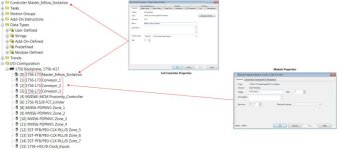Imagine the four CPUs in four separate chassis. This works exactly the same as if they were all remote.
OG
That, in a nutshell, describes the situation perfectly !!
I always make a point to my students that the "chassis" just contains a "backplane", which is a
network component, allowing whatever modules that are plugged onto it to communicate with each other.
I also point out that
every single module can be considered to a "processor", performing different processing functions. Input modules process real-world inputs into Input data tags, output module process Output data tags to real-world outputs, communication modules act as "bridges" from the chassis to other devices, so they are processing data that needs to be communicated, etc.
They all communicate with each other using the Producer/Consumer model of data exchange.
After more discussions about limitations in sharing I/O modules, I tell the students that the networked 3, 4 or 5 training rigs in the room (each with 2 controller modules), can be looked at as one "PLC" - I prefer the name DCS - Distributed Control System.
I have to stick to the course material, but if time allows I like to throw in additional exercises, e.g....
1. Use your potentiometer (analog in) to display on the panel meter (analog out) of the training rig to their right. This concentrates on configuring local and remote I/O, and usually initially gives errors because the chassis to the right still has the last exercise in the controller, which has control of the unsharable analog output module. It's a good exercise because the students see first-hand what the problems are, and how they become resolved automatically.
2. A "chat-room" - it's fun and it involves creating a bunch of produced and consumed string tags. There's no I/O or coding involved, just produce/consume tag data-exchange. Also they have to put everyone else's controllers into their I/O Configuration, nothing in the standard course material goes anywhere near that scenario.
In summary...
Any module - Any where : it's just a collection of modules on a network.





